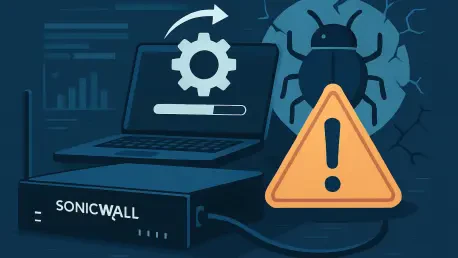In the ever-evolving landscape of cybersecurity threats, SonicWall’s recent advisory concerning its Secure Mobile Access (SMA) 100 series appliances has garnered significant attention. The series, specifically the SMA 210, SMA 410, and SMA 500v models, is subject to vulnerabilities that could potentially allow unauthorized remote attackers to exploit the system. Identified as CVE-2025-40596, CVE-2025-40597, and CVE-2025-40598, these vulnerabilities can lead to denial-of-service (DoS) conditions or the unsolicited execution of arbitrary code and JavaScript. The advisories call for urgent firmware updates to mitigate these risks effectively, ensuring the security and integrity of sensitive information for businesses and organizations relying on these appliances.
Understanding the Vulnerabilities
Pre-Authentication Flaws in SMA 100 Series
The vulnerabilities CVE-2025-40596 and CVE-2025-40597 within the SonicWall SMA 100 series represent critical pre-authentication flaws that carry a high risk for exploitation. These issues involve stack-based and heap-based buffer overflows with a CVSS score of 7.3, indicating their potential to cause significant damage. Exploiting these flaws can lead to a complete system compromise through the remote execution of arbitrary code. What intensifies the risk is that these vulnerabilities do not require any action from the user, nor do they require credentials to exploit. This lack of need for authentication makes the infrastructure perilously vulnerable to cybercriminals who can instigate system crashes, effectively causing a denial-of-service scenario that disrupts normal operations.
Furthermore, the inherent nature of these buffer overflow vulnerabilities means that attackers can overwrite memory locations, potentially allowing the execution of malicious code with elevated privileges. Such ramifications emphasize the necessity for immediate attention to the firmware updates as guided by SonicWall. The implications of leaving these vulnerabilities unpatched could lead to systemic risks within organizational networks, potentially compromising a broad range of sensitive data. Consequently, addressing these flaws is vital to preserving the safety of internal data pathways and ensuring unimpeded operational continuity within affected networks.
Reflected XSS Flaw and Its Consequences
Complementing the buffer overflow vulnerabilities is the third critical concern, CVE-2025-40598, a reflected cross-site scripting (XSS) flaw. With a CVSS score of 6.3, this vulnerability involves user interaction, such as clicking a malicious link, and can result in the injection of harmful JavaScript code into active user sessions. The consequences of such an exploitation avenue are multifaceted and include a heightened risk of credential theft, possible session hijacking, or use as a spearhead for further exploitations. This vulnerability underscores the unpredictable and often unmanned avenues through which attackers can gain entry into systems, especially within environments relying on web-based interfaces for user interaction.
Moreover, XSS attacks can serve as launchpads for more sophisticated attack vectors, allowing attackers to expand their footprint within a system. The reflected nature of the XSS flaw means that malicious scripts exploit the trust relationship between the server and the client. Given this, SonicWall’s admonition to update firmware and heed alert advisories is not only prudent but indispensable to avert potential breaches. By ensuring all links and user endpoints are safeguarded, organizations diminish the likelihood of such attack vectors being utilized effectively, thus securing organizational data from external threats seeking to exploit these vulnerabilities.
Defensive Measures and System Hardening
Implementing Firmware Updates and Enhancements
SonicWall’s advisory highlights that the primary remedial measure to combat these vulnerabilities rests in upgrading the affected appliances to firmware version 10.2.2.1-90sv or beyond. This step is critically necessary as there are no viable workarounds to mitigate the threats posed by the aforementioned vulnerabilities. It is pivotal that stakeholders and IT administrators promptly execute these firmware updates to reduce exposure to any security compromises. Aside from the initial patch installation, SonicWall has clarified that appliances such as SSL-VPN SMA1000 series products and SSL-VPNs on SonicWall firewalls are inherently immune, bringing some relief to a broader scope of users.
Nevertheless, upgrading the firmware, while fundamental, is only part of a comprehensive security posture. Organizations are prompted to reinforce additional layers of security by employing multifactor authentication (MFA) on all affected devices. This added layer serves as a robust line of defense against unauthenticated penetration attempts. Moreover, engaging the built-in web application firewall adds an effective safeguard against potential exploit attempts, thereby enhancing the overall resilience of network access terminals. Through these multifaceted defensive layers, businesses can reasonably thwart unauthorized access and maintain the integrity of their networked environments.
Monitoring and Managing Threat Landscape
Even with no current evidence suggesting the active exploitation of these vulnerabilities, situational awareness and vigilance remain indispensable. Organizations are encouraged to monitor threat intelligence channels actively and remain attuned for any potential signs of exploit attempts targeting their systems. Exploit proof-of-concepts, once circulated, may incite attempts against unpatched systems. Therefore, prompt patching combined with proactive security monitoring constitutes a cornerstone of efforts to mitigate potential attack vectors before they manifest comprehensively.
Additionally, SonicWall provides security advisories containing comprehensive mitigation instructions that administrators can utilize for effective cyber defense. These advisories detail exact firmware upgrade processes, including relevant downloads and version checks across deployed devices. Adhering to these recommendations fortifies the system’s ability to withstand attempted breaches, thus ensuring the enduring security and operational capability of the SMA 100 series appliances. As enterprises continue to leverage remote access solutions, following these prescribed security measures will prove vital in precluding exploitation and securing data assets from the multifaceted threats that permeate the cyber threat landscape.
Moving Forward with Security Mindfulness
In the constantly shifting realm of cybersecurity, SonicWall’s recent advisory about its Secure Mobile Access (SMA) 100 series appliances has drawn considerable focus. This series, which includes the SMA 210, SMA 410, and SMA 500v models, faces vulnerabilities that may expose them to exploitation by unauthorized remote attackers. Known as CVE-2025-40596, CVE-2025-40597, and CVE-2025-40598, these weaknesses could result in denial-of-service (DoS) situations or permit the unsolicited execution of arbitrary code and JavaScript, potentially compromising system security. The advisories highlight the urgency of implementing firmware updates to address these risks proactively. Prompt updates are crucial for maintaining the security and integrity of sensitive data pivotal to businesses and organizations that depend on these appliances. As cybersecurity threats evolve, maintaining timely updates is essential for safeguarding digital assets against emerging vulnerabilities and staying ahead of potential attackers.









